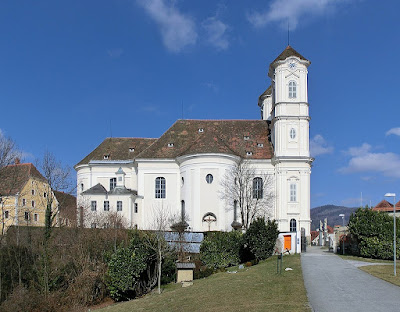Basilicas in Austria—West
Basilica of the Sacred Heart of Jesus, Hall in Tirol, Tirol
Declared a minor basilica by Pope Pius X in 1914.
The church was built between 1567 and 1570 but was secularized in 1783. It did not reopen as a church until 1914. It is now home to the Daughters of the Sacred Heart—a contemplative order.
The first picture is from the basilica's website, the second from Dreamstime, and the last two from local sources.
Basilica of Maria Plain (also dedicated to the Assumption), Bergheim bei Salzburg, Salzburg
Declared a minor basilica by Pope Pius XII in 1951.
A painting of Our Blessed Mother began to attract pilgrims in 1652. The current church was built between 1671 and 1674 to house the image. It is thought that Mozart composed his “Coronation Mass” to honor Our Lady under the title of Maria Plain.
All pictures are from Wikipedia.
Basilica of Our Lady of the Immaculate Conception, Wilten, Tirol
Declared a minor basilica by Pope Pius XII in 1957.
The Premonstratensian church is also referred to as “Our Lady of the Four Columns.” There is evidence that Catholic Roman legionaries worshiped here in the 5th Century. The Premonstratensians took over the parish in 1140 and built a church. It was replaced by the current Rococo structure built between 1751 and 1756.
All pictures are from Wikipedia.
Basilica Abbey of Our Lady, Stams, Tirol
Declared a minor basilica by Pope John Paul II in 1983.
The basilica is the church of a Cistercian Abbey established in 1273. The church was originally built in 1274 in a Romanesque style but was renovated between 1729 and 1733 in a Baroque style. The choir organ dates to 1757.
All pictures are from Wikipedia.
Basilica of Our Lady, Rankweil, Vorarlberg
Declared a minor basilica by Pope John Paul II in 1985.
The church was built in the 15th Century as part of a castle. The castle no longer exists. The church has a crucifix from the 12th Century and bells from the 15th Century.
All pictures are from Wikipedia.
Basilica of St. Michael, Absam, Tirol
Declared a minor basilica by Pope John Paul II in 1999.
St. Michael’s parish may date to the 9th Century. The original church was burned by invaders in 1413 and replaced with a Gothic building. The church was renovated in the 18th Century. The church has a crucifix from 1492 and a pipe organ from 1776. An image of Our Blessed Mother has attracted pilgrims since 1797.
All pictures are from Wikipedia.
Basilica of St. Dominic, Kramsach, Tirol
Declared a minor basilica by Pope Benedict XVI in 2008.
Two brothers established a monastery here in 1267. Dominican nuns took it over in the 15th Century and after a fire, the church was rebuilt in a Baroque style from 1680 to 1682. The monastery was closed by Emperor Joseph II in 1782, but reopened in 1863, by the Sisters of Charity of St. Vincent de Paul. The monastery is now a secular school, and the church is the parish church.
Both pictures are from Wikipedia.
Basilica of Our Lady of the Visitation, Bildstein, Vorarlberg
Declared a minor basilica by Pope Francis in 2018.
The church is located more than 800 feet above the Rhine River. It was built in a Baroque style between 1662 and 1676.
The first two pictures are from Wikipedia and the last is from a local source.
Basilica of Our Lady of the Assumption, Mariapfarr, Salzburg
Declared a minor basilica by Pope Francis in 2018.
The current church was completed in a Romanesque style in the early 13th Century to replace a 10th Century church. This church was rebuilt in a Gothic style in the 15th Century and has been remodeled and restored several times since then. Frescoes date to the 13th and 14th Centuries. Father Joseph Mohr wrote the lyrics to “Silent Night, Holy Night” here in 1816.
Both pictures are from Wikipedia.


















































































